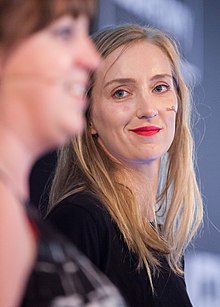Addie Wagenknecht
Addie Wagenknecht (born Portland, Oregon) is an American artist and researcher living in New York City and Austria. Her work deals primarily with pop culture, feminist theory, new media and open source software and hardware.[1] She frequently works in collectives, which have included Nortd Labs, F.A.T. lab, and Deep Lab. She has received fellowships and residencies from Eyebeam, Mozilla, and The Studio for Creative Inquiry at Carnegie Mellon University.
Addie Wagenknecht | |
|---|---|
 | |
| Born | Addie Wagenknecht April 15, 1981 |
| Nationality | American, Austrian people |
| Education | MPS Interactive Telecommunications, New York University |
| Known for | interactive art, open source, digital art |
Notable work | Lasersaur, wifitagger, webcam venus |
| Movement | Open Source |
Biography
Addie Wagenknecht was born in Portland, Oregon in 1981. She received a Bachelor of Science in Multimedia and Computer Science from University of Oregon in 2001, and a MPS from New York University's Interactive Telecommunications Program in 2007. During her time at NYU, she founded NORTD labs with Stefan Hechenberger, a research and development lab which developed open source multi-touch systems CUBIT[2] and TouchKit, as well Lasersaur, an open source laser cutter.
Her and her projects have been supported by numerous residencies and fellowships. She held Eyebeam fellowships in 2007 – 2008 and in 2013 as Eyebeam and Mozilla's first Open(art) Fellow[3] and NORTD labs was a fellow at Culture Lab in 2011.[4] During 2012 NORTD labs held residencies at Hyperwerk Institute for Postindustrial Design in Basel, Switzerland and Carnegie Mellon University's STUDIO for Creative Inquiry.
Wagenknecht was a member of the now disbanded Free Art and Technology Lab aka F.A.T. lab. Wagenknecht founded Deep Lab in 2013, which focuses on alternative market economies and creative research, using anonymity as a proxy.
Selected works
CUBIT (2007)
The first open source Multi-touch system using Diffused Illumination with software written in OpenFrameworks was developed under NORTD labs as their first open source project. CUBIT (multi-touch) was designed with the intention to redefine visual computing and depart from the mouse pointer paradigm. CUBIT (multi-touch) was originally developed as a thesis project at New York University's Interactive Telecommunications Program in 2006 and its continued research and development into 2008 as TouchKit was supported by a fellowship at Eyebeam Atelier.
Lasersaur (2009–)
The Lasersaur is an open source laser cutter designed by NORTD labs to fill the need of makers, artist and scientist who wanted a safe, cheap and highly capable machine. It started its alpha stage in March 2011 and beta stage in June 2011 after successful funding on Kickstarter. Current worldwide Lasersaur builds can be viewed on their google map page. Lasersaur systems have also been built by many universities such as New York University, University of Newcastle and Carnegie Mellon University.
WifiTagger (2012)
The WifiTagger runs on OpenWrt firmware and a TP-Link WR741ND router, likens Wi-Fi SSIDs to digital graffiti. It allows you to create four open 32-digit SSIDs which when selected directs the user to the interface to add new tags. It was developed for Free Art and Technology Lab in 2012.
Webcam Venus (2013)
In Webcam Venus is a project created by asking online sexcam performers to replicate iconic works of art. This piece was an experimental homage to both fine art and the lowbrow internet phenomenon of cams. The piece was developed for Free Art and Technology Lab in 2013 in collaboration with Pablo Garcia.
Asymmetric Love (2013)
Asymmetric Love re-uses CCTV equipment and arranges 14 cameras into a 'baroque' chandelier. It is placed as such in an entrance portal of museums or major collection houses. Asymmetric Love is a chandelier composed of CCTV cameras rather than candles or light bulbs.[5] Number 2 from the series was the highest selling lot at Phillips Auction House in New York City, curated by Lindsay Howard, for their first digital art auction in October 2013.[6]
Deep Lab (2013– )
Deep Lab was founded by Wagenknecht in 2014 with the support of The Studio for Creative Inquiry at Carnegie Mellon University to examine contemporary culture through an understanding of alternative market economies and creative research, using anonymity as a proxy.[7] The group's works are accessible via a hidden services site on the deep web. The collaborative is made up primarily of women working within privacy, surveillance, code, big data research, art and critical culture. Founding members include Jillian York, Claire L. Evans, and Lorrie Cranor.[8] In 2015 Deep Lab was in residence at NEW INC in 2015.[9]
Awards and fellowships
- Carnegie Mellon University STUDIO for Creative Inquiry Resident 2014[7]
- Artistic Bokeh Research Fellow at the University of Applied Arts Vienna 2013/2014[10]
- Artist-In-Residence MuseumsQuartier Vienna 2013/2014
- Mozilla Open(art) Fellow 2013
- Carnegie Mellon University STUDIO for Creative Inquiry Resident 2012
- Hyperwerk Institute for Postindustrial Design Resident 2011/2012[11]
- CultureLabUK Fellow 2011[11]
- World Technology Summit 2009 IT Hardware Finalist[12]
- Eyebeam Art and Technology Center Fellow 2007/2008[11]
- Wasserman Fellow, NYU 2007[11]
References
- Economist, The (May 1, 2008), Home invention, The Economist Newspaper Limited, retrieved May 3, 2008
- Gizmodo (May 4, 2008), Build Your Own Multitouch Table with the Cubit, retrieved May 4, 2008
- Thompson, Matt, Art Meets the Open Web, retrieved July 12, 2012
- Greene, Kate (May 1, 2008), Open-Source, Multitouch Display, MIT Technology Review, retrieved May 3, 2008
- Poole, Steven (January 8, 2016). "Together in electric dreams: how the art world embraced modern technology first". the Guardian. Retrieved January 10, 2016.
- http://www.phillips.com/press/2013/NY-Paddles-On-Results-Oct-2013
- "Deep Lab". STUDIO for Creative Inquiry. Retrieved March 5, 2016.
- "About Us". Deep Lab. Retrieved March 5, 2016.
- "Deep Lab". NEW INC. Archived from the original on June 30, 2017. Retrieved March 5, 2016.
- "Artist Biography" (PDF). Bitforms Gallery.
- "Interview with Addie Wagenknecht". We Make Money Not Art. Retrieved March 5, 2016.
- "The World Technology Summit & Awards 2009". www.wtn.net. Archived from the original on May 24, 2011. Retrieved March 5, 2016.